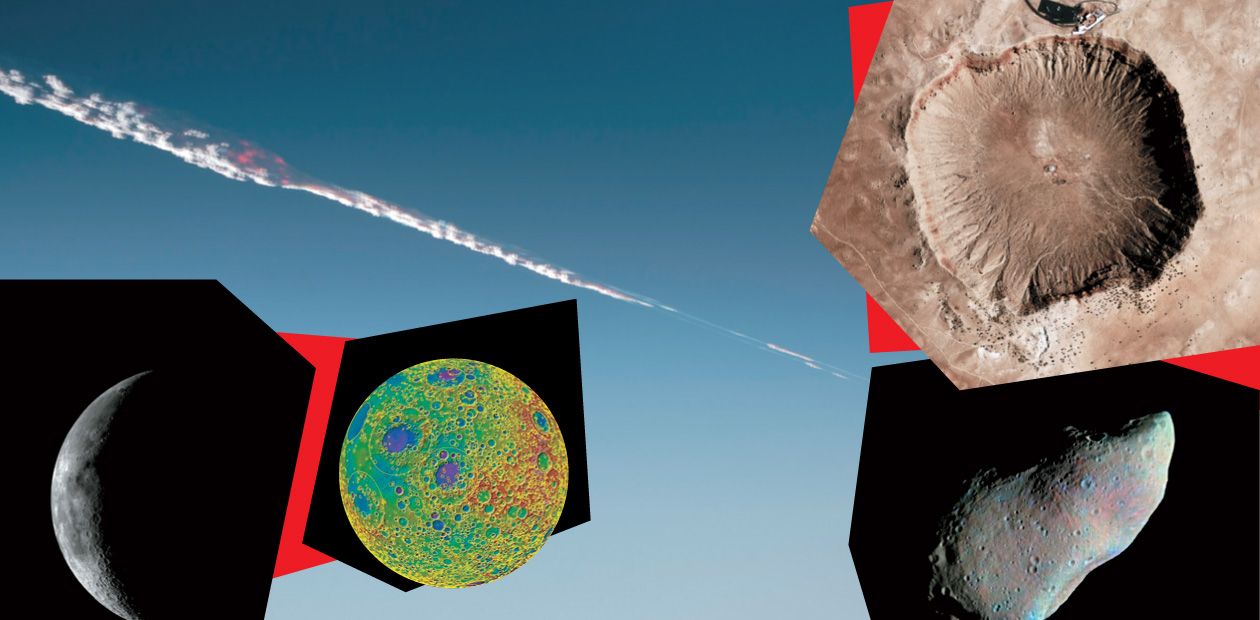“Javelin” of the Solar System
In Greek, “bolis” is a javelin. The term “bolide” is applied to a very bright meteor, that is, the glowing atmospheric trail of a large meteoroid rushing towards the Earth’s surface, similar to a thrown javelin. The widely known Chelyabinsk bolide was the most recent of such amazing celestial events. The explosion yield of this meteoroid was estimated approximately as half megaton TNT equivalent, which is 20–30 times the atomic bomb that destroyed Hiroshima. The meteorite referred to as Chelyabinsk is the largest celestial body that impacted the Earth after the famous Tunguska meteorite, which fell down a hundred years ago
The Chelyabinsk meteoroid entered the Earth’s atmosphere from the east at a small angle to the horizon at a tremendous velocity (about 18 km/s). Based on the initial mass and diameter of the celestial body (about 9—10 kilotons and 17 m, respectively), its density was estimated approximately as 3.5 g/cm3, which corresponds to the undifferentiated stony meteorites (2.0—3.7 g/cm3). The considerable explosive power of this comparatively small stone body can be explained by its avalanche-type fission and subsequent drastic increase in the deceleration force in the atmosphere, resulting in the conversion of a large part of kinetic energy into heat.
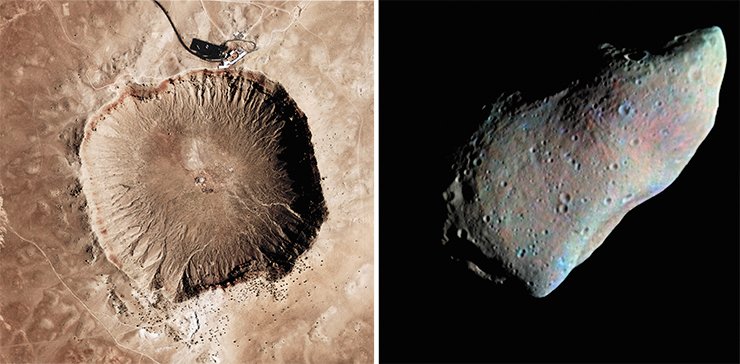
There is an empiric rule that no more than 10% of the initial mass of sufficiently large celestial bodies entering the Earth’s atmosphere reach its surface. Taking into account the initial mass of the Chelyabinsk meteoroid, several hundred tons of meteorite material must have fallen down on the ground. The assumed distribution ellipse of this meteorite (approximately 130×20 km) stretched from a site south- and westward of Chelyabinsk to the city of Zlatoust; therefore, it is likely that larger fragments will be also found in this vast area.
While the “trail was still hot,” partially fire-polished small fragments of meteorite material with a total weight of 3.5 kg were found. The initial assay of these fragments demonstrated that the meteorite was composed of ordinary chondrite belonging to LL5 chemical group, where LL is the abbreviation denoting that it contains a very low share of iron and other metals (approximately 1.7 wt%) as compared with other similar meteorites; 5 is a petrological type (the highest type is 6), indicating a heat metamorphism (alteration) of the meteorite substance that took place before its impact with the Earth. The main minerals contained in this meteorite are olivine, ortho- and clinopyroxene, plagioclase, chromite, troilite, apatite, and iron-nickel alloy.
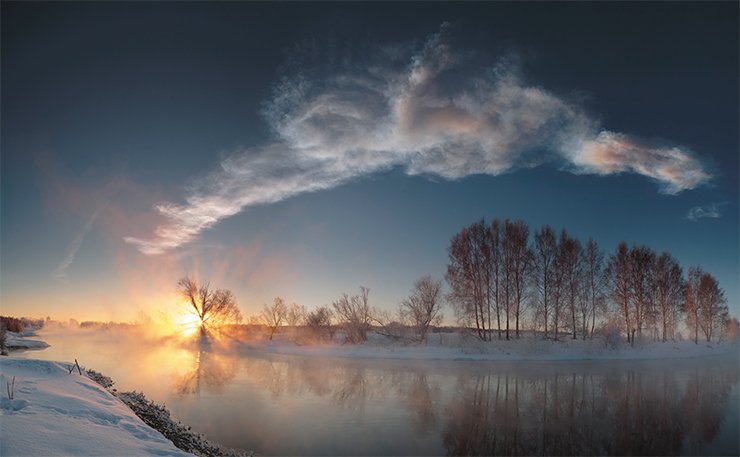
According to D.D. Badyukov (Vernadsky Institute of Geochemistry and Analytical Chemistry, Russian Academy of Sciences, Moscow, Russia), a member of the Committee on Meteorites, who examined the fragments of the Chelyabinsk meteorite, its composition is rather uniform, its more precisely determined density being 3.2 g/cm3. As for the age of this meteorite, it was estimated as 4.5 billion years, being typical of all ordinary chondrites.
There is also the concept of a cosmic age of meteorites, which corresponds to the moment when their parent body was destroyed and they appeared as individual space objects. This age is determined by the accumulation of cosmogenic isotopes (such as 10Be and 14C) caused by particle fluxes. The cosmic age of the stony and iron meteorites varies in a very wide range with a maximum of 108 years.
The concept of a terrestrial age of meteorites refers to the time span between the impact with the Earth and their discovery, during which the meteoritic material is changed by erosion
These data suggest that the meteorite was formed in the Main Asteroid Belt and that its parent body was several hundred kilometers in size. One more interesting fact: it is likely that the asteroid that gave rise to the meteorite had experienced a strong impact. Presumably, this was a collision with another massive celestial body; as a result, its substance became loose and the numerous cracks preserved solidified impact melt.
Parameters of the bolide are still being examined; for this purpose the data of infrasound, seismic, and meteorological stations and numerous video records are used.
Once in a century
Events similar to the impact of Chelyabinsk bolide are ubiquitous on the Earth, and every now and then they leave behind noticeable “traces,” craters.
The most illustrative example of this kind is the well preserved Arizona Meteor Crater, or the Barringer Crater, with a diameter of 1.2 km and a depth of 180 m, in the north of Arizona (United States). Geological examination and numerical simulation have demonstrated that this crater appeared 50,000 years ago owing to the impact of a fifty-meter meteorite with a weight of 300,000 tons and a velocity of 12—17 km/s. The resulting explosion was threefold more powerful as compared with the Tunguska body; the meteorite itself almost completely dissipated and evaporated despite its prevalently metal composition. The total mass of cosmic matter falling out onto the Earth’s surface over one year is, according to different estimates, 100 to 1000 tons. Meteoroids enter the Earth’s atmosphere at a velocity ranging from 11.2 km/s (“overtaking” trajectories) to 72 km/s (opposite trajectories) in any direction at any time of the day and of the year.
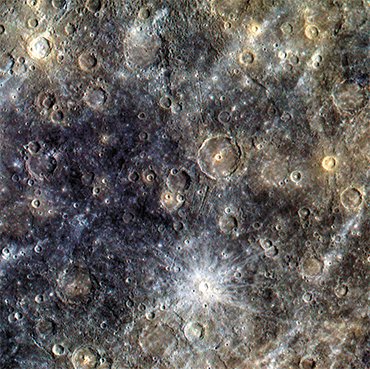
If all the cosmic objects with a size above 10–8 m entering the atmosphere daily are recorded, their number will reach 70 million! However, only the particles exceeding 10–4 m are able to cause the effect of a meteor, that is, to leave a radiant trail in the atmosphere observable by eye, photo imaging, or radiolocation. Celestial bodies with a weight of over 1 kg give the effect of a bolide, which can end in an explosion and the falling of fragments. Of the meteoritic material falling on the Earth, approximately 92% are stony meteorites, 6% are iron bodies, and 2% are iron-stony ones.
Note that the atmosphere is a powerful gas filter protecting the Earth against an intensive flux of small falling bodies. The forming of an impact crater depends on the mass, size, composition, and physical state of a celestial body that reaches the Earth’s surface. In general, the following pattern has been inferred: the larger the meteoroid body, the lower its average impact rate. For example, the probability of an impact of a body similar to the Chelyabinsk meteorite is estimated as one event per century while of that similar to the Tunguska meteorite, per one millennium. As for the earlier period of the Earth’s history, these probabilities were considerably higher.
The most dangerous are impacts of large bodies, such as asteroids and nuclei of comets larger than 1 km, which can cause a catastrophe on a regional or even global scale. According to the data of the IAU (International Astronomical Union) Minor Planet Center, over 7,000 asteroids heading for Earth have been detected so far (these asteroids belong to Aten, Apollo, and Amor groups); 900 of them have a diameter exceeding 1 km.
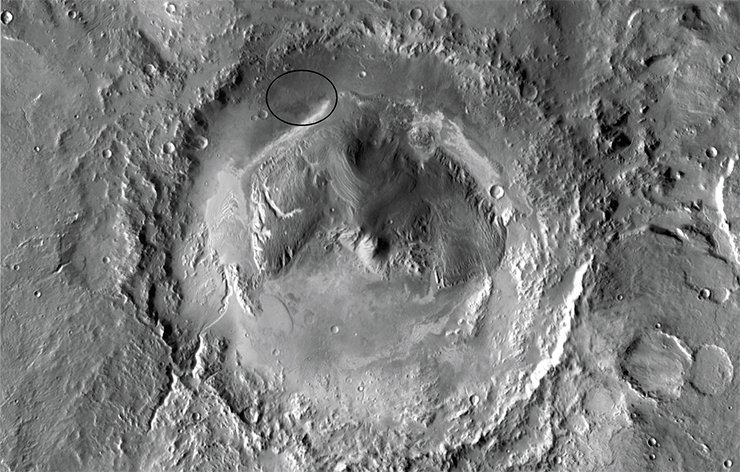
The coordinates of these asteroids can be computed for any specific moment; however, their orbits are periodically changed, being influenced by gravitational excitations of the inferior planets, and therefore require constant adjustment.
The eccentric orbits of periodic comets are even less predictable, and appearance of new comets cannot be forecast at all. When speaking about celestial bodies of the Chelyabinsk meteorite type, their number in the near-Earth space is estimated as 100 million. On the other hand, technical capacities for monitoring the celestial guests are still rather limited: it is feasible to detect only the bodies no smaller than 50 m in diameter several days before they start approaching the Earth and, in addition, only if these bodies display sufficiently high reflectivity for solar light.
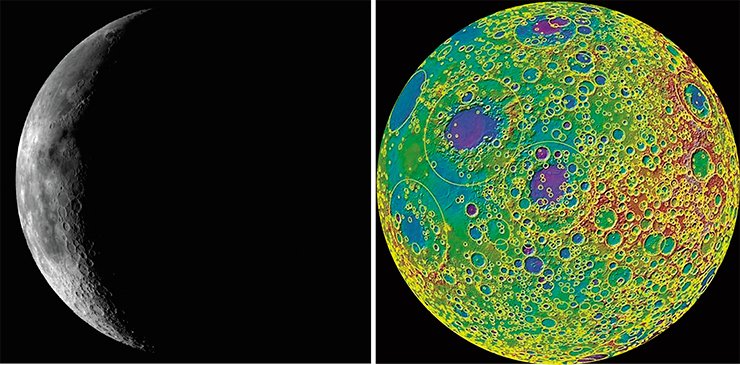
The devastating consequences of the Chelyabinsk impact turned the “asteroid–comet threat” from a theoretical area to an evident and topical problem that requires a practical solution. This means the creation of a system that would provide for the timely detection of the celestial bodies over 10 m in size that approach the Earth and the efforts for their destruction or change in their trajectories.
Terrestrial and “celestial” craters
One may assume that when in 1609 Galileo Galilei focused his telescope on the Moon for the first time, he saw many ring structures of an unknown nature; although in his treatise Sidereal Messenger (Sidereus Nunicus, 1610), among the discoveries he had made on the Moon, he mentioned only lunar mountains. People managed to understand the origin of lunar craters only three and a half centuries later.
It is noteworthy that the Paris Academy of Sciences officially recognized the space origin of the stones falling onto the Earth as late as the early 19th century, although corresponding evidence had been obtained and published by several scientists (for example, by E. Chladni, a German physicist, and by E. King, a member of the Royal Society of London) considerably earlier. Then, gradually came the understanding of the consequences potentially caused by the impacts of meteorites and larger celestial bodies on the Earth, Moon, and other planets. As for the lunar craters, the discussion of their nature (volcanic or explosive) continued up to the mid-20th century. The examination of the moon surface with Soviet and American space probes as well as with the help of manned Apollo missions has demonstrated that the absolute majority of lunar craters are explosive.
Note that the term “explosive” is not completely accurate in this situation. Craters on the surface of atmosphereless celestial bodies, such as the Moon and almost all planet satellites and asteroids, are formed by the impact of bodies moving at cosmic velocities. In this case, an explosion rather than a mechanical shock takes place at the moment of the impact of a falling body on a larger body; as a result of the explosion, a considerable amount of substance of both the “target” and “hammer” is evaporated, melted, processed, and ejected from the ground zero. Experimental and theoretical simulations have demonstrated that the values of these ejections are determined by a set of parameters of the colliding bodies, including their physical (velocity, mass, mechanical strength, and so on), physiochemical (composition of matter and its phase state), and geometrical (impact angle and body size) characteristics.
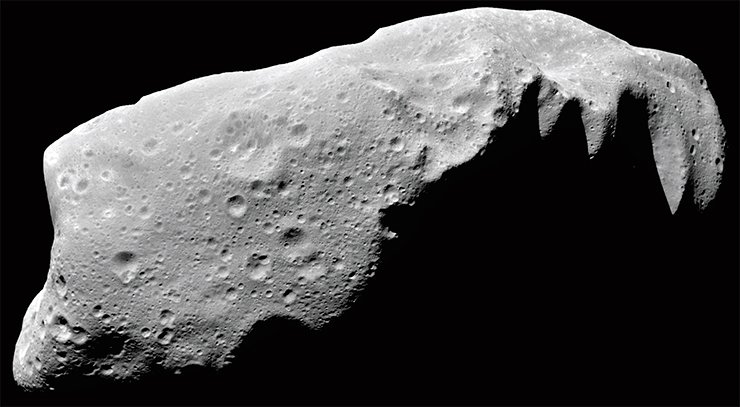
As for the planets that have an atmosphere, the craters are formed according to another pattern. Deceleration of a large gravitating body in the atmosphere leads to a partial or complete loss of its kinetic energy and to its conversion into other forms (an explosive wave in gas and in the body itself, thermal and light emissions, etc.) before its collision with the planet’s surface. Correspondingly, craters on the Earth’s surface are formed only by the impacts of sufficiently strong (for example, metal) or large bodies for which the atmosphere is not a significant barrier. In contrast, impacts of considerably smaller and less strong bodies are able to form craters on the surface of Mars, the density of whose atmosphere is approximately one-third of that of the Earth.
The recognition in the early 19th century of the fact that celestial bodies actually impacted on the Earth induced a targeted search for impact-caused structures over all continents. However, the examination of the first discovered impact-caused craters, the so called astroblemes, was hard work, and the obtained results were rather contradictory. These studies, first and foremost, involved geologists, for they were able to detect the unusual specific mineralogical, geochemical, and other features of such structures against the background of typically terrestrial rocks.
Over almost a century, since the year of 1827, they attempted to find out the origin of a group of nine Kaali craters in Saaremaa Island (Estonia), the largest of which has a diameter of 110 m and a depth of 22 m. It was as late as 1937 that I. Reinwald, a mining geologist, succeeded in proving their meteoritic nature, since he found several pieces of meteoritic iron in two craters.
The history of the Arizona Meteor Crater was no less dramatic. Before the beginning of the 20th century, this crater was regarded as a volcanic one. However, in 1902 D. Barringer, an American mining geologist, basing his assumptions on numerous small meteoritic iron fragments found on the bottom and beyond the rim of the crater, suggested that it was of meteoritic origin. Barringer spent the last 26 years of his life trying to find a large fragment of this meteorite on the bottom, aiming to extract nickel, but in vain.
It was only in the 1940s—1950s, when aerial survey became widely used in geological prospecting and assessing other natural resources, that it became clear that round geological formations of an unusual structure abounded on the surface of the globe. Comprehensive examination of these structures demonstrated that they were astroblemes, the traces of the impacts of celestial bodies.
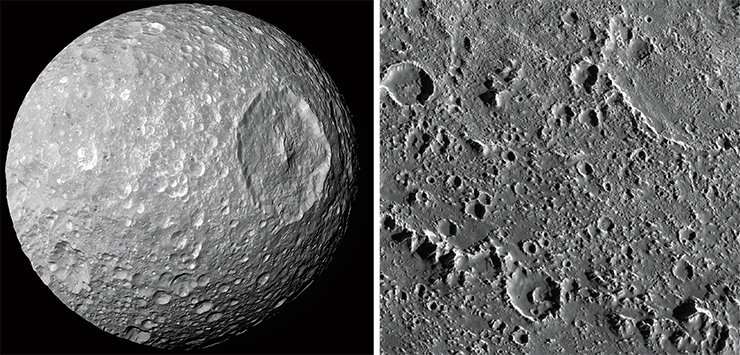
Currently, the large-scale structures of the known astroblemes are studied and the new ones are searched for with the help of multispectral aerial surveying. The total number of the known astroblemes with a diameter of 10 m to 340 km is about 200 (35 of them are on the territory of the former Soviet Union). Their age ranges from 2.5 billion years ago to the present time. Note that small craters with a size not exceeding several tens to hundreds of meters (accounting for 15% of all craters) are no older than a million years.
“Children” of asteroids
Large-scale research into the solar system with the help of space probes, which began in the second half of the 20th century, has shown that not only the Earth and the Moon are covered with impact-caused craters. Explosive structures have been found on all known solid bodies of the solar system. They are numerous on Mars and on atmosphereless Mercury; they are visible on all the satellite images of the Main Belt asteroids, located in-between the orbits of Mars and Jupiter as well as on the satellites of planets.
Asteroids are celestial bodies with a size of approximately 50 m to several hundred kilometers. Since the moment they are formed, they remain almost unchanged as compared with the planets and their satellites, whose matter has been essentially modified by magmatic melting, differentiation, and other factors. Therefore, it is asteroids that retain the traces of all processes in the solar system on their surface, explosive events included. Various properties of asteroids (structure of their surface, reflectivity, rotation, dimensions, mass, average density, parameters of their orbit, and so on) are important sources of such “historical” information. Analysis of all the data for a large number of bodies gives an insight into the early stage in the evolution of our planetary system.
Note that the irregular shape of almost all asteroids is combined with a heavily cratered surface. First and foremost, this means that such asteroids are the fragments of some larger bodies. Presumably, these parent bodies fragmented during their collisions, caused, as it follows from current dynamic numerical models, by the fact that large rapidly moving protoplanetary bodies originating from the zones of growth of Jupiter and other terrestrial planets entered the Main Asteroid Belt.
On the other hand, the heavily cratered surfaces of asteroids suggest that the intensive flux of the bodies impacting them did not stop after these asteroids were formed. Presumably, only the largest asteroids, such as 1 Ceres, currently regarded as a dwarf planet, 2 Pallas, and 4 Vesta, have escaped havoc and represent the “survived” parent bodies.
The masses and precise dimensions of some asteroids measured by space probes that approached these bodies made it possible to estimate their mean density.The density appeared to be considerably lower than the typical density of their constituent minerals and rocks as compared with analogous terrestrial specimens, which indicates either the high porosity of asteroids or internal cavities in them. Evidently, all the mentioned specific features of asteroids result from their catastrophic origin and explosive evolution.
It has been already proved that most of meteorites are fragments of asteroids. The cooling rate of meteoritic substance has been assessed according to the properties of the so-called Widmanstätten patterns, formed in crystallization of the iron-nickel alloy in iron meteorites and in small iron particles of stony meteorites. This rate was shown to correspond to the cooling rates of the inner parts of the bodies with sizes ranging from several tens to several hundred kilometers, which fits the dimensions of asteroids. In their optical characteristics, the main types of meteorites (iron, iron-stony, and stony containing chondrites and achondrites) whose properties match the taxonomic (spectral) types of asteroids.
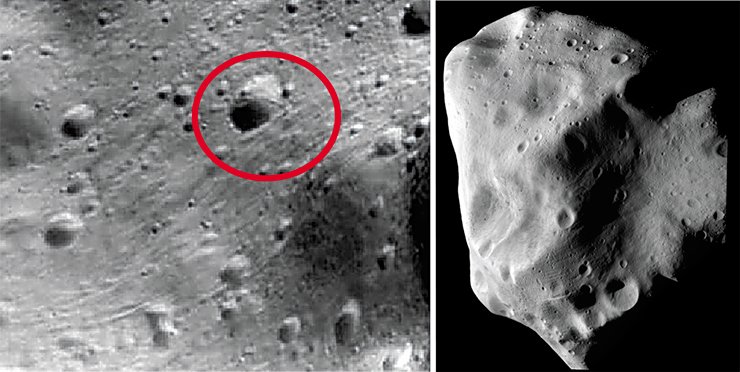
Moreover, groups of meteorites have been discovered whose properties almost coincide with the observed characteristics of individual celestial bodies. In particular, there are “Moon meteorites”, which are close or identical to the lunar samples that have been brought to the Earth. There are also “Martian meteorites” as well as meteorites composed of the volcanic rocks whose properties match the corresponding material of Vesta asteroid.
The existence of such meteoritic groups demonstrates that in the event of strong impacts individual fragments of planetary bodies can be expelled into space, and eventually they reach the Earth’s surface. In essence, this is a mechanism of an impact-induced matter exchange between planets. Note that the finest meteoritic particles with a size of ~10–5 m or less can reach the Earth’s surface almost without any damage. Owing to the considerable value of the surface area-to-volume ratio of such particles, they are efficiently decelerated and cooled in the uppermost atmosphere, with a subsequent free fall onto the Earth’s surface.
Various properties of meteorites (mineralogical, geochemical, petrological, isotopic, etc.) allow researchers to determine and trace the sequence of physiochemical processes in their parent bodies.
Space supply
Collisions of celestial bodies do not always end in their catastrophic collapse. As it follows from cosmogonic models, the early stage in the evolution of the solar system was “constructive”: low-speed collisions (actually, fusions) of numerous small bodies gave rise to the so-called planetesimals with a wide range of sizes. When these objects grew up to several kilometers in diameter, they merged due to gravitational attraction. This process, referred to as accretion, promoted the growth of protoplanets. Accumulation of thermal energy during accretion and decay of short-lived isotopes in sufficiently large (200 km and bigger) planetary embryos triggered the initial heat evolution, involving the melting and differentiation of matter.
The transfer of matter in the collisions of bodies differing in their compositions may be also regarded as a “constructive” process. The fact is that similar stone-ice planetesimals could have been formed in the solar system beyond the so-called “water ice condensation boundary”, i. e. at the distance from the Sun where these bodies were never heated above 0 °C and where water ice could be formed. By the way, it was the occurrence of numerous planetesimals that promoted a rapid formation of the embryos of proto-Jupiter and other giant protoplanets.
According to the solar system evolution model created by O. Yu. Schmidt and V. S. Safronov, well-known cosmogonists, the temperature of the proto-Earth and other terrestrial protoplanets during their formation was rather high. This has been confirmed by numerous geochemical and mineralogical analyses of compositions of the most ancient rocks.
During the magmatic evolution and differentiation, the Earth had to lose almost all “volatile” part of its composition if we assume that its initial material was a substance of chondrite or carbonaceous chondrite type. Another catastrophic event that could lead to a complete loss of the volatile components was an impact-induced formation of the Moon from the Earth’s body via a collision with a giant protoplanetary object of the Mars’ size. The fact that isotope ratios in the terrestrial and lunar materials match confirms this hypothesis of the Moon’s origin.
A logical conclusion from the above-mentioned theories was the hypothesis implying that the currently existing atmosphere and hydrosphere of the Earth was formed from the matter of celestial bodies (asteroids, comet nuclei, meteorites, and stardust) impacting on it after its surface had cooled. However, computations suggest that the flux of the smallest objects (dust and meteorites) during the entire history of Earth was insufficient to deliver the water amount contained in the oceans.
The main volume of water and other volatile compounds could appear on the Earth only via the impacts of larger bodies like asteroids and/or comet nuclei, carrying water in a frozen or bound state. The more so since statistical analysis of the age and sizes of lunar craters confirms the high intensity of the flux of falling large bodies during the early stage in the Earth–Moon existence, i.e. about 4 billion years ago. In addition, numerical simulations suggest that at the time of the impact of a sufficiently large body, a certain part of it avoids heating to high temperatures and reaches the Earth’s surface undamaged, which is also confirmed by the fragments of the Chelyabinsk meteorite. Paradoxical as it may seem, asteroids and comets, which had been threats to the terrestrial life throughout its existence, most likely created the conditions for the origin of this life.
“GRAINED” METEORITESChondrites are divided into ordinary and carbonaceous (dark in color) types. The matrix of ordinary chondrites consists of approximately the same minerals as their chondrules. As for the matrix of carbonaceous chondrites, it mainly (up to 90 wt%) consists of low-temperature hydrosilicates such as serpentines, chlorites, and other minerals with a high (1—22 wt%) content of bound water. There is also a separate group of carbonaceous chondrites composed of a matrix alone, the material of which has never exceeded 100—200 °C.
Carbonaceous chondrites display several other unusual properties. In particular, their low-temperature matrix contains up to several percent of carbon as complex hydrocarbon compounds, including alcohols and amino acids. We are not sure about where and when these compounds were formed; however, it is clear that the hydrosilicates of carbonaceous chondrites were formed because of an early internal heating of meteoritic parent bodies, i. e. asteroids, owing to the energy source of 26Al (with a half life of 0.72 million years) and other short-lived isotopes. So, 26Mg, the daughter isotope of 26Al, was detected in several stony meteorites, including the known Allende meteorite, found in Mexico in 1969.
The impacts of comet nuclei on the Earth may have brought not only water, but also rather complex organic compounds that were generated in outer space owing to short wavelength radiation and particle fluxes of solar and space origin.
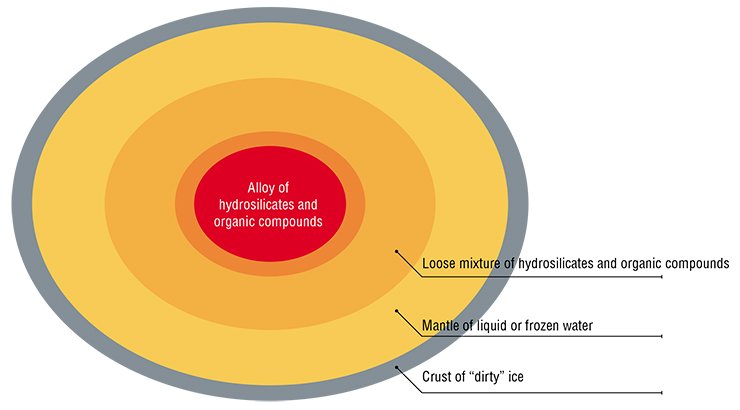
Besides, the situation with water per se on the Earth is not so simple. In particular, the studies of meteor dust particles have demonstrated that the isotope compositions of comet and ocean water are different. This suggests that the “comet” source cannot be regarded as the main one. On the other hand, the isotope composition of “terrestrial” water and water inclusions in carbonaceous chondrites is the same, suggesting that the main water volume was delivered to the Earth by these celestial bodies.
This conclusion is confirmed by the following interesting results of the author. Spectral observations of the S-, M-, and V-type asteroids, which were formed under high temperatures, similarly to the Earth, have shown that most of these bodies contain non-typical hydrosilicates. The presence of these hydrosilicates can be explained by the impacts of primitive carbonaceous chondrite bodies on asteroids.
“Genealogy” of asteroids
The unusual properties of carbonaceous chondrites, which played such an important role in creating the conditions for the origin of life on the Earth, are determined by the conditions under which the chondrites were formed. Their laboratory reflectance spectra characterizing the matter composition are very similar to the reflectance spectra of C-type asteroids; consequently, the latter were regarded as the parent bodies for carbonaceous chondrites. According to the author’s hypothesis, both carbonaceous chondrites and C-type asteroids originate from the same source, namely protoplanetary bodies in the zone of Jupiter’s formation.
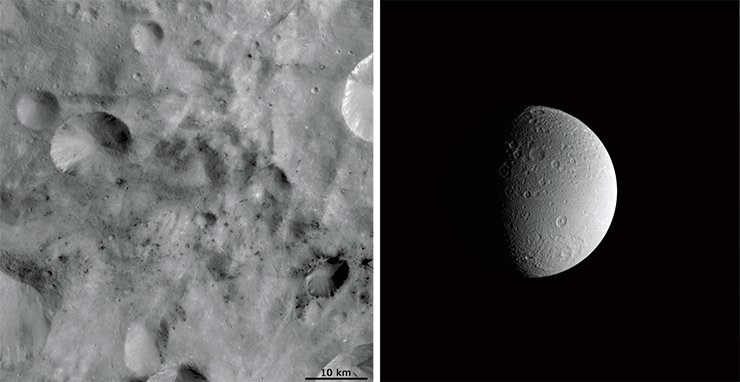
When Jupiter’s core mass reached several Earth’s masses, accretion of smaller-sized protoplanetary bodies to it stopped. Moreover, these bodies then were expelled far beyond the zone of Jupiter’s formation, particularly into the Main Asteroid Belt, located nearby (Safronov, 1969). Since the zone of Jupiter’s growth was beyond the water ice condensation boundary, all the protoplanetary bodies that emerged there were composed of stone and ice. The composition of comet nuclei and stardust suggests that the volume content of silicates, ices, and organic compounds there was approximately the same.
As for the larger bodies (over 200 km), heating of their inner parts through 26Al decay led to ice melting, which gave rise to an inner aquatic ocean. Owing to the differentiation of water, they formed large silicate-organic nuclei with a radius reaching two-thirds of the radius of the bodies themselves. While the temperature of free water was always close to +4 °C, the temperature in the nuclei could be by one order of magnitude higher because of a relatively higher 26Al concentration. Presumably, these nuclei became a kind of chemical reactors where hydrosilicates and complex organic compounds formed over 5–10 million years until 26Al ran out and the ocean froze.
Gravitational excitations of Jupiter transferred protoplanetary bodies to elongated orbits which not only spanned the Main Asteroid Belt, but also were likely to reach the terrestrial planets. Because of a wide range of their velocities (1 to 30 km/s) and orbit eccentricities, the consequences of their impacts on the parent bodies of asteroids were different. Due to the catastrophic collisions at maximal speeds, most of these bodies could be either swept out of the Main Asteroid Belt or be completely split. As for the protoplanetary bodies that moved at minimal velocities along low eccentric orbits, they were likely to remain in the Main Belt after a series of nondestructive collisions.
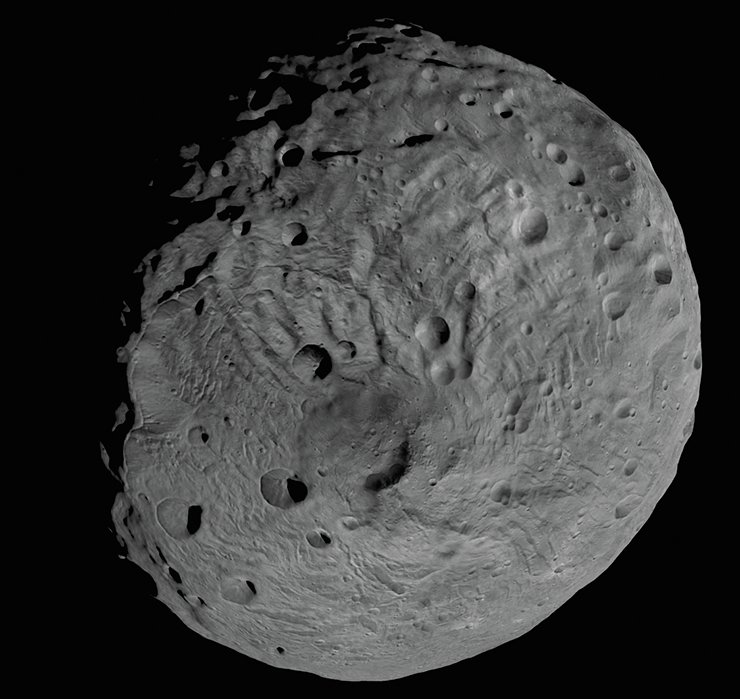
The differences in the degree of uniformity and composition of the stony-ice bodies from the Jupiter zone and the parent bodies of asteroids were also to play an important role. The higher mechanical strength and uniformity of the latter could cause the splitting of protoplanetary bodies in collisions.
Thus, the most abundant class of asteroids of the Main Belt, C class, was, most likely, formed of large fragments of destroyed protoplanetary bodies out of the zone of Jupiter’s formation. Another group is the parent bodies of asteroids covered with a thick layer of carbonaceous chondrite-like material, resulting from the impacts of small fragments of split protoplanetary bodies.
This explanation for the origin of C-asteroids and carbonaceous chondrites agrees with the hypothesis proposed by H. Urey (1952), a well-known American researcher, on the origin of chondrules in chondrites. In his opinion, chondrules are drops of molten silicate material expelled into outer space in the mutual collisions of asteroid-sized bodies which baked before they fell down onto the surface of closest celestial bodies.
Conceivably, carbonaceous chondrites of different groups were formed at different degrees of impact conversion of the initial matter: the bound water content in a form of hydrosilicates successively decreases in these groups, whereas the relative content of chondrules, on the contrary, increases. It is important to emphasize that not only carbonaceous chondrites, but also ordinary chondrites might have been formed in this way.
As is evident from the detailed images of asteroid Vesta, taken in 2011 with the help of NASA’s Dawn spacecraft, its surface is pockmarked with numerous craters containing spots of dark material that displays the spectral characteristics matching those of carbonaceous chondrites. Earlier similar data were obtained for Lutetia, a high-temperature asteroid, with the help of ESA’s Rosetta spacecraft.
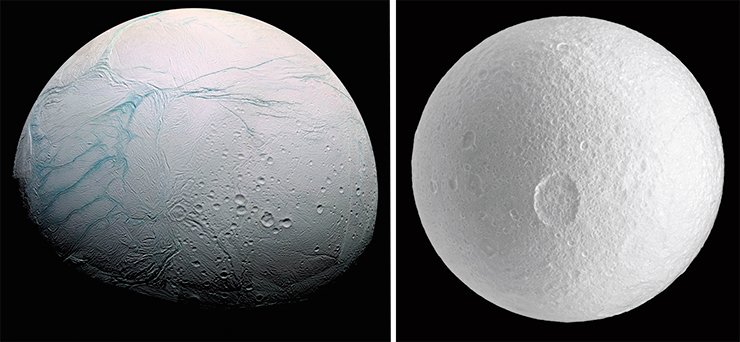
The specific features in crater locations and associated ejections of matter suggest that the impact events that formed the craters on Vesta and Lutetia opened subsurface deposits of ancient dark material with carbonaceous chondrite composition. These discoveries are a direct confirmation of existence of an intensive flux of primitive bodies that was directed to internal planets, the Earth included, which appeared at the beginning of the solar system evolution.
On the other hand, no spots of dark material whose origin can be associated with impacts have been found on some celestial bodies of the outer part of the solar system. In particular, uniformity of the light cratered (and, correspondingly, ancient) ice surface of Saturn satellites, such as Enceladus and Tethys, is surprising. This is one of the riddles to be solved.
The Chelyabinsk impact once again reminded all people on Earth of the existing asteroid–comet menace from space. The shock wave induced by the explosion of this meteoroid injured more than a thousand people – it is the first experience of this kind in the history of civilized mankind. We should be aware that such a threat to people will grow with the increase of the size and density of human population.
Research into meteorites and impact craters on the Earth’s surface not only has clarified the real causes of such events, but also has made it possible to go above and beyond the terrestrial world. The epoch of space flights, which started in the mid-20th century, has given the opportunity to see the surfaces of other planetary bodies and even “look into” their depths. A comparative study of various celestial bodies formed the background of the theory of evolution of the solar system, starting from the moment it emerged. Thus, the humankind has to admit that the potentially threatening flux of space objects headed to the Earth is associated with eternal and inevitable formation and destruction via collisions of celestial bodies.
References
Dodd R. T. Meteorites. A petrologic-chemical synthesis. Cambridge University Press, 1981.
Melosh H. J. Impact Cratering: A Geologic Process. Oxford University Press, New York, 1989.
Bronshtjen V. A. Fizika meteornyh javlenij. M.: Nauka, 1981. (in Russian)
Busarev V. V. Spektrofotometrija asteroidov i ee prilozhenija / LAP LAMBERT Acad. Pablish. GmbH & Co. KG, Saarbrücken, 2011. (in Russian)
Ivanov B. A. Raspredelenie udarnyh kraterov i asteroidov po razmeram // Katastroficheskie vozdejstvija kosmicheskih tel / Red. Adushkin V. V., Nemchinov I. V. M.: IKC “Akademkniga”, 2005. S. 118—150. (in Russian)
Safronov V. S. Jevoljucija doplanetnogo oblaka i obrazovanie Zemli i planet. M.: Nauka, 1969. (in Russian)


